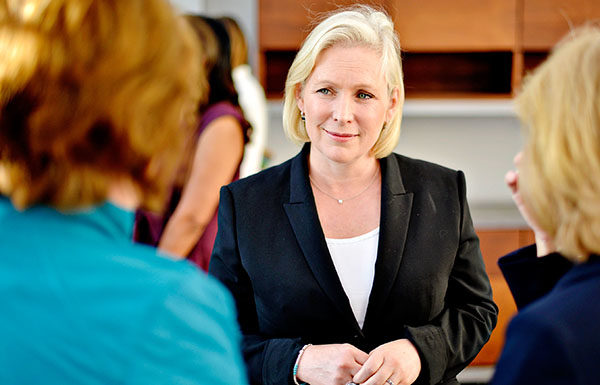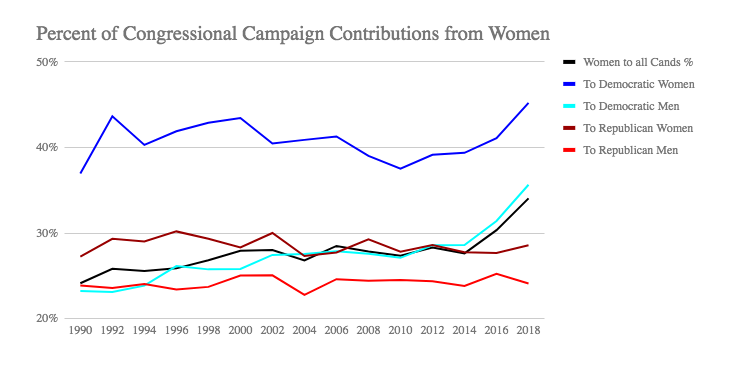
© Jerod Harris/Getty ImagesSenator Kirsten Gillibrand (D-NY)
With the 2018 elections well underway, women have led a surge in political activity, both as candidates and as donors. We are not only witnessing
women setting records in the number of secured major party nominations for the U.S. House, but we are also seeing a significant increase in the percentage of congressional campaign contributions coming from women. However, over the course of this record-breaking political year, the gender gap still looms strong and the party gap even stronger.
Looking at the congressional campaign contributions from women over time, an analysis of Federal Election Commission data shows female candidates tend to benefit most from female donors.
For the 2018 election cycle, seven of the top ten Senate candidates with the highest percentage of itemized contributions from women are active female candidates. All of the top recipients are white candidates, only two come from southern states, and all but Sanders are Democrats.
Of the total number of campaign contributions in the 2018 congressional elections, 34 percent came from female donors, a significant increase from 2016. The number of campaign contributions from women in this election cycle-almost $296 million so far-is more than the total amount of money given by women in the 2016 elections-nearly $286 million. The total percentage could still tick upwards in the coming weeks of election season.

GOP women are struggling to ride the same wave as their Democratic female counterparts. Although the amount of money coming from women has increased in these elections, Republican candidates have not seen the benefits of this trend. Historically, campaign cash from women favors Democrats, and the trend has continued in these elections. 45 percent of campaign contributions for Democratic female candidates come from women-much more than the 29 percent their Republican female counterparts receive from women. The amount of money coming from female donors has remained static for Republican women and the amount of money coming from female donors has fallen for Republican men.
Since the 2016 elections, the percentage of campaign contributions coming from women for Republican men has dropped precipitously. Moreover, the total number of campaign contributions given by women to Democratic women has surpassed the total number of contributions given by women to Republican men.
So far in the 2018 congressional elections, Democratic women have received $95.6 million in campaign contributions from women, which is a stark difference compared to the $64.8 million Republican men have received from women. During the 2016 congressional elections, Republican men received nearly $106 million in congressional campaign contributions from women and Democratic women received $74.9 million.
Despite the steady increase of cash from female donors, men still make up the vast majority of campaign contributions to congressional candidates-66 percent of campaign contributions come from male donors. Democratic men have received the highest amount of congressional campaign contributions from both female and male donors. Democratic men have received $120.2 million in congressional campaign contributions from women and $217 million from men. All of which is to say that the story here is about party in addition to gender.
Although male donors still dominate campaign contributions, women have come a long way. Since the last 'Year of the Woman' in 1992-when Anita Hill's treatment by the Senate Judiciary Committee fueled a similar record-breaking wave of women participating in elections-we've witnessed a huge increase in the percentage of congressional campaign contributions coming from female donors.
In 1992, 26 percent of all congressional campaign contributions came from women. That number has now increased to 34 percent in these current elections. Only seven House candidates in 1992 received half or more of their campaign contributions from women. In 2016, the number was 12. So far in the 2018 elections, 51 House candidates and four Senate candidates have received half or more of their campaign contributions from women. Female donors and candidates have a long way to go to decrease the gender donation gap, but they're certainly getting closer to cracking this particular glass ceiling.
Reader Comments
to our Newsletter